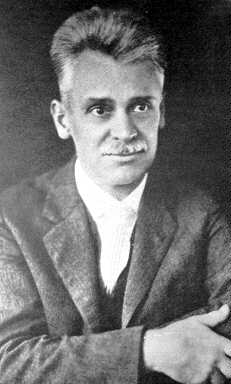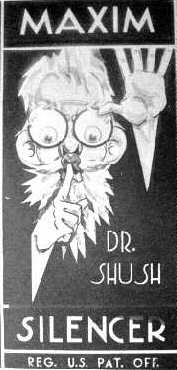27.09.1999:
On the Control of Silencers in the United States

by Mark White
A Bit of Historical Background
In 1909 Hiram P. Maxim invented one of the first metal silencers for
reducing sound levels in firearms. Silencers were innovatively marketed as the gentleman's
way of target shooting. They turned out to be quite popular, and sold quite well through
the 1920s, and into the early '30s. The Great Depression of the 1930s left many
people out of work, leading some to poach game in order to keep their families from
starving. Concurrently, crime in the 1930s rose dramatically. It was in this context that
attempts were made at passing legislation prohibiting handguns and machine guns. The Second
Amendment to the U.S. constitution, however, prevented such legislation, and the
courts struck it down. Eventually the concept of taxation was used to evade the wording in
the Second Amendment.
Image: Hiram Percy Maxim, the inventor of first commercially
successful gun silencer.
"Can't Ban - Tax It!"
In 1934 a bill was passed levying a tax of $200 (4 times the price of a Thompson
submachine gun at the time. For more info see Kickback link "Lex
Morgenthau".) on future sales of machine guns. Short-barreled rifles and
shotguns, cane guns and silencers were also thrown into the bill, almost as an
afterthought. The BATF was set up, and one of its functions today is to collect
such a tax. So much of the controversy dealing with Title II weapons is not that they are
illegal, but that a tax will be levied on their ownership. Owning one which is not
properly registered and taxed is a violation of federal tax code (tax evasion) a felony
punishable by large fines and up to ten years in prison.
In the interim, included in that tax collection effort has been the process of
fingerprinting, photo identification, and a background check for evidence of criminal
activity and/or mental defectiveness. Typically, the most populated states (CA, NY, &
NJ) are very restrictive and have their own laws preventing the ownership of firearm
silencers. Today 33 states allow the possession or use of firearm silencers or
suppressors. Seventeen do not. Title II weapons are tightly regulated and controlled by
the federal government and its agents in the Bureau of Alcohol, Tobacco and Firearms.
In general, state, county and municipal entities may own and use machine guns, silencers
and destructive devices in any state.
Each weapon or device will carry its own model, make and serial number, as an aid to
identification and tracking of the piece. For identification purposes a silencer is
considered to be a weapon by BATF, even though its purpose is to reduce the sound of a
firearm's report, not to discharge a projectile. We are not here to issue a moral or
fairness judgement, but merely to report what exists in today's bureaucratic world.

Bureaucratic Hearing Protection
While a number of Title II weapons exist on today's market, some continue to be made
today. They are manufactured by federally licensed, Class II manufacturers. These
individuals and companies have applied to the federal government for the required licenses
and permits, have been interviewed at least once by a BATF agent, have been fingerprinted,
and have been the subject of an extensive security and background check by the Federal
Bureau of Investigation. While one must hold a Federal Manufacturer's License to build
weapons and devices, one must also hold a Special Occupational Tax (SOT), the full value
of which costs $1,000 a year to maintain. When a licensed Class II Manufacturer constructs
a weapon or device it is immediately serial numbered and registered with the National
Firearms Act Branch of BATF on a Form 2 document. These are either faxed or mailed in
duplicate to the NFA Branch, and normally take from 20 to 30 days to be properly
documented. An agent of the NFA Branch will approve the form and return a copy to the
manufacturer.
Image at right: The famous "Dr. Shush" logo of
original Maxim silencers - the gentleman's way of target shooting. Not until today the firearms noise control topic has been found again
as a solution against shooting range noise pollution and for ensuring effective shooters'
hearing protection.
Law enforcement agencies will gain access to the registered weapons and devices through a
Form 5, which may be filed with the NFA Branch by another agency, a Class II manufacturer,
or a Class III dealer. These normally take about 20 days to clear. A physical transfer
will not be allowed to take place until the proper paperwork has been received. Law
enforcement agencies often maintain NFA-registered devices in their inventory. When a
weapon or a device is issued to sworn officers those devices remain under the control and
ownership of the agency. Departmental policy sometimes allows an individual officer to
actually own a Class III weapon. That weapon may be transferred to the officer on a
tax-free Form 5 document, or on a $200, tax-paid Form 4. Qualified individuals may also
obtain Title II, Class III weapons through the use of the tax-paid Form 3. This requires
two fingerprint cards, two Form 4s, a law-enforcement approval, a $200 check paid to the
U.S. Treasury, and an extensive FBI background check.

A cut-away model of Maxim silencer.
A Form 4 normally takes 90 days to process, and a transfer will not be allowed to take
place in any state which does not permit individual or corporate ownership of such a
device. Dealers and manufacturers transfer weapons between themselves on a tax-free Form
3, which takes approximately 30 days to process. Again, a physical transfer shall not take
place until the appropriate form has been approved by the NFA Branch of BATF. A Class III
Dealer or a Class II manufacturer may file form 5 transfers to law enforcement entities
anywhere in the U.S. Form 4 transfers can only be filed for qualified individuals and
corporations within a dealer or manufacturer's state of residence.

Right: Sound Tech Dark Star suppressor for centerfire rifles.
U.S. Military and Police
Military ownership and distribution of NFA weapons is not normally controlled or affected
by the NFA Branch. Each military entity has its own rules for the distribution and control
of these devices. Some groups exercise extremely tight control. Other groups are less
formal, and do not serially number their weapons and devices. Those without numbers and
markings of any kind are said to have been sanitized, or sterilized. While we won't dwell
on the quantities of sanitized weapons that have been kicked out of low flying aircraft
over foreign soil, we will say that control of NFA weapons and implements of war is
extremely tight inside the U.S.; while the reverse of that may have at times been true
outside U.S. borders.

Left: White's integral Ruger MKII suppressor.
In general, sound suppression devices for firearms are legitimately used by law
enforcement agencies for a number of purposes. The largest quantity are used daily by
animal control officers and contractors in municipalities, parks, botanical gardens and
airports. Firearm sound suppressors are also used heavily by animal control personnel in
agriculture, forestry, reservoir and waterway management. In most cases stealth is not so
much an issue as is public relations.
 In tactical use firearm sound suppressors are
primarily employed by entry teams in buildings, as the discharge of any weapon inside a
structure will cause both temporary and permanent hearing loss if hearing protection is
not employed. While head phones and ear muffs are available, many officers refuse to use
them, as they prevent the detection of suspect movement inside a structure to a large
extent. In addition, there is again the aspect of public relations, and the reduction of
firearm noise also reduces the amount of PR fallout if deadly force has to be employed.
Firearm sound suppressors are also used on police sniper rifles, not so much to totally
eliminate the sound of discharge, but to soften its intensity, mask the source and allow
the shooter(s) to see bullet strike.
In tactical use firearm sound suppressors are
primarily employed by entry teams in buildings, as the discharge of any weapon inside a
structure will cause both temporary and permanent hearing loss if hearing protection is
not employed. While head phones and ear muffs are available, many officers refuse to use
them, as they prevent the detection of suspect movement inside a structure to a large
extent. In addition, there is again the aspect of public relations, and the reduction of
firearm noise also reduces the amount of PR fallout if deadly force has to be employed.
Firearm sound suppressors are also used on police sniper rifles, not so much to totally
eliminate the sound of discharge, but to soften its intensity, mask the source and allow
the shooter(s) to see bullet strike.
Right: Ruger 10/22 rifles with Soud Tech suppressors.
Related links:
Sound Technology website
with a regular newsletter about
ammunition development and other current topics.
Gunwriters on the Web story about Silencer Control in the United States: http://guns.connect.fi/gow/silencer.html